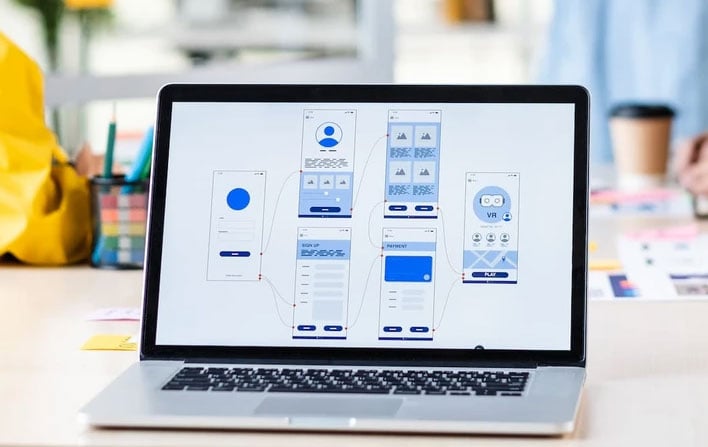Think about the last time a brand genuinely wowed you - that super smooth online checkout, a quick, helpful chat with support, or a recommendation that felt spot-on. That 'wow' moment? That's customer experience (CX) design in action.
It's the intentional craft behind every interaction, making things easy, intuitive, and even enjoyable. When you get CX right, customers don't just buy; they stick around, come back, and tell their friends. Simply put: better experience, better results.
And as the European Accessibility Act pushes businesses toward more inclusive and standardized digital experiences, nailing your CX design isn’t just smart - it’s expected.
In this guide, we’ll break down how to engage your audience through customer experience design, helping you craft journeys that are not only functional but also memorable.

What is customer experience design?
Customer experience design involves crafting and refining interactions across all stages of the customer journey - before, during, and after conversion. Design teams use customer-focused strategies to create meaningful experiences that engage users at every touchpoint and build lasting connections with the brand.
Overall, CX design is not just about aesthetics, it’s about making customer experiences feel effortless, personalized, and on-brand at every step. And it does have actual impacts on your business! You get loyal users, better conversion rates, and a brand experience people actually remember.
According to Forrester Research, a well-designed user interface can increase website conversion rates by up to 200%, while improved UX design can boost conversions by up to 400%.
Principles in action: How to engage your audience through Customer Experience Design
At Niteco, we have over 15 years of experience in customer experience design for global brands across industries like premium home appliances.
Our work with AEG Australia is a standout example - by taking a customer-centric approach to redesigning their digital experience, we helped them boost performance, improve engagement, and win the award for Most Customer-Centric Digital Experience in APAC & Japan.
So, we know what can help your business engage audience with customer experience design. Let's check out the list below!
Know your audience inside out
Why it matters: You can’t solve problems you don’t understand. A successful experience starts with empathy - truly knowing who your audience is and what they care about.
Put it into action:
- Start with audience behaviour research: Use Hotjar or similar for heatmaps and session recordings to get real-time data on what they’re interested in the most. A more time-consuming method is to deploy in-depth surveys and conduct one-on-one interviews to understand their needs, pain points, and desires, which can be used as user personas for future usage.
- Segment smartly with CRM tools like HubSpot, Klaviyo, or Salesforce. Divide audiences by lifecycle stage, behavior, engagement history, or even psychographics—allowing you to tailor messaging, UX flows, and offers that actually resonate.
- Keep data fresh by integrating behavior-tracking tools like GA4 to continuously monitor and spot subtle shifts in user expectations and preferences over time. Schedule quarterly reviews to spot trends, shifts, or new expectations emerging in real time.
Map and optimize the user journey
Why it matters: Without a clear view of the user journey, it’s easy to miss the moments that make or break conversions. Journey mapping helps you zoom in on what really matters.
Put it into action:
- Visualize the full path to identify every step and interaction your users take, from first click to post-purchase.
- Spot the friction using funnel analysis and session recordings to pinpoint where users abandon tasks, repeat actions, or pause too long. Look for signs of confusion, hesitation, or frustration.
- Elevate each stage with relevant content, intuitive UI, and timely guidance - whether it’s a helpful tooltip or an upsell at just the right moment.

Personalize every interaction
Why it matters: Generic is forgettable. Personalization grabs attention, drives engagement, and makes users feel understood.
Put it into action:
- Use AI and your data to personalize product recommendations, follow-ups, and next steps based on actual behavior - like browsing history, cart activity, or past purchases.
- Customize landing pages, email content, and special offers based on specific user behavior or the segments they belong to, not just by name, making every interaction feel unique to them.
- Automate critical flows like post-signup welcome sequences, cart abandonment reminders, and post-purchase follow-ups with thoughtful timing and value-driven content - not just "hey, you forgot something”.
Explore more about how personalized marketing strategies unlock business growth.
Ensure consistency across touchpoints
Why it matters: Consistency builds trust. When users see the same tone, visuals, and experience across channels, they know they’re in good hands.
Put it into action:
- Establish clear brand guidelines for tone, voice, visuals, and messaging to stay aligned across web, app, email, and support.
- Integrate your tech stack - sync your CMS (e.g., Optimizely), CRM (e.g., Salesforce), and marketing automation (e.g., Hubspot) to ensure consistent data and messaging across platforms.
- Audit regularly (like email flows, landing pages, mobile UX) to catch outdated copy, misaligned visuals, or inconsistencies between web and mobile experiences.
As an Adobe partner, we also help brands leverage Adobe Experience Manager to unify content and design consistency across every channel.
Continuously evolve with data and feedback
Why it matters: Customer experience isn’t “set it and forget it.” Markets shift, expectations rise, and behaviors evolve. The best brands constantly refine based on what’s working - and what’s not.
Put it into action:
- Track your core KPIs - keep a pulse on metrics like CSAT (Customer Satisfaction Score), NPS (Net Promoter Score), churn rate, and time-to-convert. These tell you how well your experience is performing at each stage.
- Use A/B testing and behavioral analytics to refine micro-interactions like button placements, email subject lines, or homepage banners. Use platforms like Optimizely Experimentation to validate assumptions with real users.
- Listen to qualitative feedback from open-ended survey questions, customer service chats, or reviews. These anecdotal stories often highlight emotional barriers or unmet needs that numbers can’t reveal.
Want to take a closer look at how to do A/B testing? Let us guide you through.
Measuring the success of your Customer Experience Design
It’s one thing to build a great experience - it’s another to know it’s working. That’s where smart measurement comes in. The best CX strategies are backed by data, insights, and constant feedback. When you track what matters, you can see what’s resonating, what’s falling short, and where there’s room to level up.
Core CX metrics to monitor
- Customer Satisfaction Score (CSAT): A quick check-in on how happy your customers are after an interaction. Think of it as a real-time pulse on experience quality.
- Net Promoter Score (NPS): How likely are your customers to recommend you? This one speaks volumes about loyalty and long-term brand love.
- Customer Retention Rate: Are they coming back? This tells you if your experience is strong enough to keep people around.
- Customer Lifetime Value (CLV): A great CX should boost long-term value. This stat connects experience to actual revenue.
Don’t just look at the numbers - Listen too
Metrics are powerful, but they don’t tell the whole story. You need qualitative insights to understand the why behind the data.
- Surveys (with open-ended questions) help you tap into customer thoughts and emotions. What did they love? What frustrated them? What suggestions do they have? These direct inputs provide invaluable narratives that metrics alone cannot reveal, guiding you to specific areas for improvement.
- Usability testing uncovers those hidden UX hiccups—the kind that drive people away without saying a word. By observing real users interact with your website, app, or product, you can spot unexpected points of confusion, frustration, or inefficiency that impact the overall experience.
By combining this powerful duo - hard data with real human feedback - you get a full picture of how your CX is performing - and where to take it next.
Common mistakes in Customer Experience Design and how to avoid them
Even the most well-thought-out customer experience plans can miss the mark if a few key things slip through the cracks. The good news? Most mistakes are totally fixable once you know what to look for.
Ignoring customer feedback
You’re collecting reviews and surveys - but are you actually using them? If not, you're sending the message that customers don't matter.
Build regular, reliable feedback loops right into your CX strategy, and make sure there are clear, accountable processes to analyze and act on those insights. Showing your customers you're actively listening and adapting is incredibly powerful.
Overcomplicating the journey
We've all been there: too many clicks, confusing menus, or just a digital maze. That's a fast track to user fatigue and, yep, abandonment.
Keep it simple. Focus on the clearest path to action and test it with real users. Less friction = more conversions.
Neglecting mobile optimization
Nothing frustrates users faster than a clunky, slow, or difficult-to-use website or app on their smartphone. Prioritize fast load times and a mobile-first layout to keep things smooth, quick, and frustration-free on any screen.

Fast is the new normal. See why load time matters and what you can do to speed things up.
Lack of cross-functional alignment
This happens when your internal teams (think product, marketing, sales, support) are all working in their own silos. This almost always leads to a totally disjointed and confusing customer experience, with mixed messages flying around.
The fix? Break down those walls! Get key players from every department involved in your CX planning from day one. A unified internal vision means a truly seamless and delightful external experience for your customers.
Conclusion
The big takeaway for dodging these CX pitfalls? It's simple: CX design isn't a 'one and done' deal. It's an ongoing journey of testing, iterating, and improving. Fuel this process with real customer data, regular usability testing, and agile workflows that let you adapt and refine like a pro.
Need a partner to help you design journeys that hit the mark? Let’s create something better - together.
